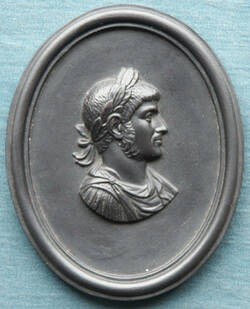Further Media
The English potter Josiah Wedgwood (1730-1795) left his mark on the age of Classicism like no other. Inspired by ancient vases and glasswork, he developed ceramic masses in the 1760s that allowed for new forms of design and ultimately created an aesthetic in its own right. At the same time, through skilful marketing, he stimulated demand across Europe, which he was also able to meet through the early industrial organisation of his business.
These four oval portrait medallions are made in so-called basalt ware (also known as black basalt ware), a coloured mass of manganese and iron salts that becomes so hard and fine-grained after firing that a glaze is no longer necessary. It was one of Wedgwood’s most successful inventions and he himself is said to have referred to it as “sterling”, or silver money. As the reliefs on display here illustrate, basalt ware can be shaped with extreme precision, thereby producing an astonishingly smooth surface.
They are part of a series, in this case mainly of portraits of rulers from the Roman imperial period, which, according to a 1779 catalogue by the firm Wedgwood & Bentley, were treated as cabinet pieces or could serve to decorate chests of drawers, bookshelves and desks. Elsewhere it says that black basalt imitates the character of ancient bronzes, which is why it was not only used to make decorative reliefs like the ones on display here, but also busts, vases, candlesticks, jugs and various other vessels. The well-known Leipzig art dealer Carl Christian Heinrich Rost, who had “considerable business connections and friendships” with Wedgwood, advertised them in his sales catalogue as early as 1786.
Text: Alexander Röstel


